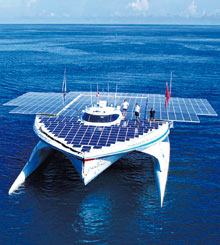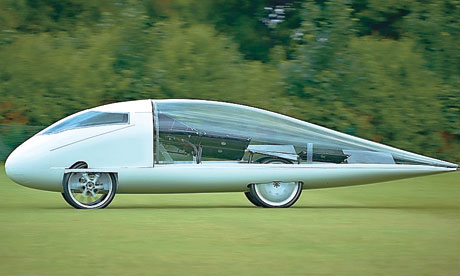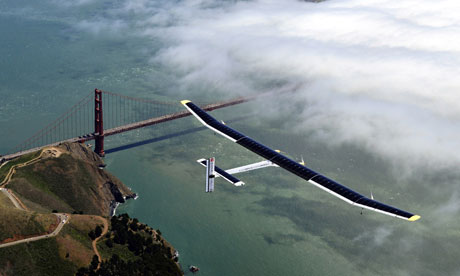The wings of the experimental aircraft arch more than 63 metres, the same span as an Airbus A340, but they look frail, supported on the airstrip by wheeled struts. They are covered in a patina of 11,268 photovoltaic cells, which look dark blue in the grey predawn. The four 10-horsepower propellers they power now start to spin silently. Bertrand Piccard, a 55-year-old explorer and psychiatrist, dons his helmet and oxygen mask and completes his final checks. The Solar Impulse quietly taxies forwards. The plane is travelling impossibly slowly – 30km an hour – when it gently noses up and leaves the ground. With air beneath them, the rangy wings seem to gain strength; the fuselage that on the ground seemed flimsy becomes elegant, like a crane vaunting in flight. It seems not to fly, though, so much as float. Piccard spends the day wheeling the solar-powered plane around the Matterhorn and lands 12 hours later, after sunset. But the Solar Impulse is a plane that would fly for ever.
This summer, it limited itself to crossing the US. It took off from San Francisco in May and flew past the Statue of Liberty before landing at JFK in July, traversing the country in five stages, with Piccard and the other co-founder of the project, André Borschberg, a former fighter pilot in the Swiss air force, swapping places in the cockpit. The flight was a remarkable achievement: the Solar Impulse flew further than any solar-powered aircraft before.
The plane that crossed America is a prototype, with the name HB-SIA. Its successor, the HB-SIB, currently being built, will try to circumnavigate the world in 2015, using about as much power as a scooter does. With no rival, it will have the skies to itself, but on land and on sea, too, a new generation of solar-powered vehicles is making extraordinary journeys, around the world and across continents. Solar power can seem the least exciting of clean energy sources: it just sits there, soaking up the sun. At least wind turbines turn. Now, though, a number of projects across the globe are pushing the boundaries of technical knowledge and coupling them to daring and demanding adventure. That the technology involved might also one day save the planet is a nice bonus.
Piccard started the Solar Impulse project because he had a problem with fossil fuels, a personal one – they had nearly cost him his life. In March 1999, along with British pilot Brian Jones, he made the first non-stop circumnavigation of the world by balloon, in Breitling Orbiter 3. "We started with 3.7 tonnes of liquid propane," he says today. "We landed with only 40 kilos." Piccard swore his next circumnavigation would rely on clean energy alone.
As remarkable as the Orbiter 3 flight was – Piccard was competing against extremely well-funded competition including Richard Branson and Steve Fossett – it was also anachronistic. The first nonstop aerial circumnavigation of the Earth was completed in 1949; the first non-refuelled circumnavigation was in 1986 by Dick Rutan. To make the undertaking epic, Piccard had to impose constraints, flying in a technologically advanced form of a technologically redundant vehicle, the balloon: a great adventure by virtue of the clauses attached to it. "Orbiter 3 was the end of 200 years of ballooning," Piccard says. "But Solar Impulse is the beginning of a new cycle in the history of aviation."
It is also a new type of exploration, a new breed of adventure. Piccard knows about both. His father, Jacques Piccard, piloted a submarine to the deepest point on Earth, seven miles underneath the sea to the Challenger Deep, in the Mariana Trench (no one has gone deeper since); his grandfather, Auguste Piccard, a physicist and friend of Albert Einstein's, invented a balloon that he flew to a record height of 10 miles in May 1931, becoming the first person to enter the stratosphere and to see the curvature of the Earth. (My book, The Explorer Gene, tells the story of these three remarkable generations of the same family.)
 The MS Tûranor PlanetSolar passes Bora Bora in the Pacific on its voyage around the world. Photograph: EPA
The MS Tûranor PlanetSolar passes Bora Bora in the Pacific on its voyage around the world. Photograph: EPA
Today, though, according to Bertrand Piccard, the job of the modern explorer is "preserving, if not improving, the quality of life on our planet. I think the pioneering spirit is not any more to conquer the planet, because it's been done. There have been 12 people on the moon. Is it useful to be the 13th or 14th one? I don't care. I think now the pioneering spirit should be more about the quality of life, better governance of this planet. Solar Impulse is a symbol of this mindset. We can do better now."
Piccard and Borschberg initially considered a zeppelin-like solar-powered airship but realised it would be just as difficult to make as an aeroplane and would be less quick through the air. In November 2003, with only a feasibility study of the project and a model plane complete, they announced the Solar Impulse project. They spent the next decade raising money and building the company ("It's extremely close to running a startup," says Borschberg, who has founded three technology businesses) at the same time as inventing the very means for this new type of adventure.
Its solar cells are 135 microns thin – the same as a human hair; its motors waste only 6% of the energy they consume, compared with a typical bleed of 70%; its carbon fibre panels that form the structure of the wings and fuselage are, at 25g/m squared, three times lighter than writing paper. The new plane, the HB-SIB, can fly through night and day, clear skies and storms, at a top speed of 70km an hour. "We built the first plane with the technology of 2007," Piccard says. "We built the second plane with the technology of 2015."
Solar Impulse is based in Lausanne, Switzerland. If Piccard needs advice on what a clean energy circumnavigation takes, he doesn't have to go far. PlanetSolar was the first around the world, in a 31-metre, space-age-looking motorboat called the MS Tûranor PlanetSolar, and is headquartered in the same city. "There must be something in the water and in the air also," PlanetSolar's managing director and cofounder, Pascal Goulpié, says, referring to the different nautical and aerial approaches. Goulpié says the simultaneous development of solar-powered vehicles – PlanetSolar was founded two years after Solar Impulse – was because of advances in the commercial photovoltaic market: "It was a time when the PV industry was starting mass production, but at the same time when its market share was very small. The basic concept was to show the maturity and reliability of solar. It was to show what we can do with PV energy. The amount of energy the Earth receives from the sun in one hour is enough to power the total human power consumption for a year. The technology is here, mature and available."
The boat began its circumnavigation in September 2010, cruising at a speed of 7.5 knots – "the idea was not to be the fastest, but the first" – and travelling under a French military escort off the coast of Sudan and Yemen. It returned to Monaco, completing the journey, in May 2012. Although the boat was slow, it was extremely efficient: it was able to travel for three days even without sun, thanks to its storage capabilities and lower power demands. And the solar technology proved completely reliable. "It's a very impressive feeling to navigate without smoke, without vibration, with a large boat in complete silence." Now, the MS Tûranor PlanetSolar is serving as a scientific platform for researchers studying the Gulf Stream. For Goulpié, "it was important from the beginning not just to demonstrate, but to make some concrete application".
Sky and sea present unique challenges for solar vehicles, which require unique solutions and a lot of funding – Solar Impulse's budget, over 10 years, is €90m; it cost €15m to build PlanetSolar. Solar cars are cheaper and offer the chance for lower cost, bottom-up innovation. Cambridge University Eco Racing has developed a solar-powered car that will race 20 other vehicles 3,000km across the Australian outback in October. The team behind it comprises 60 students at the university, "without much academic input", according to project manager, Keno Mario-Ghae, a 20-year-old engineering student at Girton College. Cuer's budget is only £500,000, much of it donations in kind – and that's still five times the budget of previous year's attempts (the first World Solar Challenge race was held in 1987; Cuer was founded in 2007). The team also turned to crowdfunding platform Kickstarter to solicit hundreds of small donations; anyone who donates £10 or more via PayPal will also get their name on the side of the car.
Those contributions, combined with resourceful thinking, add up: through the Kickstarter campaign alone, Cuer was able to pay for an innovative glass canopy that distinguishes its vehicle from competitors. "All solar cars are designed as big flat tabletops to collect as much sun as they can," Mario-Ghae explains. "Our idea is more; if you can build a car that's small and aerodynamic, you don't need so much power to run. So you can afford to use less surface area. You don't need to build a big flat tabletop." This year's Cuer vehicle racer, called Resolution, is the shape of a teardrop. At its rear, "space-grade" solar panels constantly reposition themselves to face the sun, thanks to an algorithm that combines GPS, the car's direction and the time of the day to work out the sun's position; the glass canopy makes the car aerodynamic and lets in 95% of the sunlight. "We did a lot of maths – a lot of painful maths – and we think this design should be very competitive, potentially race-winning."
 Resolution, the solar-powered car developed by Cambridge University Eco Racing, which is due to compete with 20 other vehicles in a 3,000km race across the Australian outback in October.
Resolution, the solar-powered car developed by Cambridge University Eco Racing, which is due to compete with 20 other vehicles in a 3,000km race across the Australian outback in October.
The car is tiny (4.5 metres long, 0.8 metres wide at its widest and 1.1 metres tall at its tallest) but has a top speed of 140km an hour. Even more impressive, Cuer went from drawing board to finished vehicle in eight months. "Everyone is trying to push the boundaries," says Mario-Ghae. "If you do things the way they've always been done, you're always going to get the same result. No one buys into us because of our eco credentials. It's because it's different and it's an extra that it's eco as well."
Cuer's radical reinvention of the solar car was prompted by a rule change from the race's organisers, stipulating among other things that race vehicles should have four wheels instead of the usual three as well as larger cockpits. "There's more of an emphasis on safety. That forces the designs to be a bit more transferable."
The hope is that the hi-tech being invented for these grand expeditions starts to appear in workaday contexts. This month, Dutch researchers unveiled a prototype family car that can travel 420 miles on a sunny day and 250 miles when there is no sunshine, at a low price: its solar cells cost only £2,000. Interactive Fully Electrical Vehicles is an Italian company set up to commercialise solar-powered vehicles for the continent's roads. And the US version of the electric Nissan Leaf features a solar panel on its spoiler that trickle-charges the auxiliary battery.
All these initiatives have a common goal. "We are in close contact with Solar Impulse, of course, and with solar race cars," Goulpié says. "In a different way, we are all working in the same direction, ready to spread solar technology and to show to as large as audience as possible that we can use this technology day to day."
Still, the emphasis of Solar Impulse, PlanetSolar and the World Solar Challenge is on the spectacular. As Goulpié puts it: "PlanetSolar is an expedition – it's an exploration to show what the current technology is able to offer human beings." That inspiration creates a virtuous loop: Mario-Ghae was inspired to take up engineering after he saw Cuer present an earlier solar car design. "They were telling me they could have a car go at motor racing speeds using the same power as a toaster," he remembers. "In my head, I was, like, 'Wow, how is that possible?' It's the whole spirit of adventure. We don't just want to innovate; we want to inspire the next generation as well."
Piccard sums it up: "The goal is to change the mindset of people through Solar Impulse. If a plane can fly around the world with no fuel, nobody can say that we cannot reach incredible goals with clean technology. You have a lot of resistance to change, a lot of people saying, 'I don't believe in that' because of dogma. They are afraid of change and they are not pioneers.
"Adventure is about the unknown. If you do something that really faces the unknown, faces the doubts, the uncertainties, and you have to develop new skills to make it happen – that's interesting."

